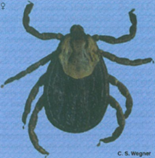Need assistance? Call 800.996.4402
Menu
Need assistance? Call 800.996.4402

The Rocky Mountain wood tick – also known more simply as the wood tick – gets its name from its primary distribution in the Rocky Mountain states and its preferred habitat of wooded areas.
Similar to the lone star tick, the Rocky Mountain wood tick is considered a three-host tick because each feeding stage requires a different host. This tick species becomes active with the first warm days of spring, usually feeding from mid-March to mid-July – when humans are most susceptible to wood tick-related diseases. Larvae and nymphs feed mainly on rodents such as voles, chipmunks and squirrels. Adults prefer to feed on medium to large animal hosts including sheep, deer and humans.
The Rocky Mountain wood tick is a primary vector of Rocky Mountain spotted fever, a severe infectious disease with a mortality rate of more than 20 percent. A tick needs to be attached for more than two hours before the disease is transmitted, so early detection is key. The main symptom is a full body rash that develops 2-5 days after the bite.
This tick species can also transmit Colorado tick fever and tularemia, and is known to cause tick paralysis when it feeds for at least 5-6 days.
Rocky Mountain wood ticks are usually found in wooded areas with low-growing vegetation, open grasslands and around trails. This tick is found at higher densities at lower elevation. This environment helps them easily attach to a passing host that brushes against the vegetation. Nymphs and adults overwinter in ground debris.
Outdoors, experts recommend wearing tick repellent and long-sleeved clothes. Homeowners should keep grass cut low and ensure weeds and woodpiles are removed.
If a tick is found on the body, use fine-tipped tweezers to grasp it as close to the skin’s surface as possible. Then, pull upward with steady, even pressure and avoid twisting or jerking the tick as this can cause the mouthparts to break off and remain in the skin. Once the tick is removed, thoroughly clean the bite site with soap and water. Then, flush the tick down the toilet or wrap it tightly in a tissue before disposing in a closed receptacle. If you develop a rash, headaches, pains or fever, call a doctor immediately.






For the very best food safety consulting, auditing and training, please visit our strategic partner, CFS Food Safety